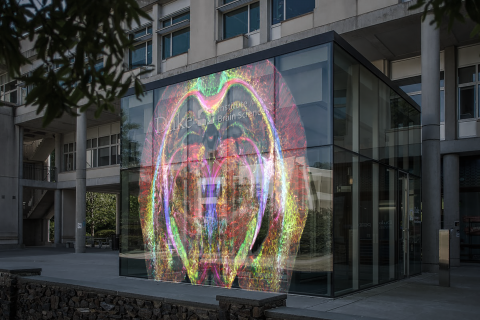Brain Portal: Designing Multimedia Displays for Duke Neuroscience (2024-2025)
Background
The most complex object in the known universe is the human brain. It is also one of the most beautiful; however, its beauty is seldom accessible to the general Duke community. The signature presence of neuroscience at Duke is the Duke Institute for Brain Sciences (DIBS), which mainly occupies an underground space at the Levine Science Research Center (LSRC). Therefore, the excitement of neuroscience discovery and the beauty of the brain is largely hidden from the general Duke population and only experienced by “insiders” who choose this path of discovery and visit these sequestered research and teaching spaces. In order to engage more effectively on campus and beyond, there needs to be more compelling neuroscience education tools such as displays, visualizations, design media and gamified applications that can contribute to communicating the complexity and wonder of neuroscience and the human brain.
Project Description
This project team will explore emerging technologies to develop creative ways of visualizing the brain and brain science for both public impact and educational purposes. Team members will employ a conceptual, technical and humanistic approach to gather and curate digital assets from the brain science community at Duke, showcasing their work and the beauty of the brain at various levels of exploration and visualization. The team will aim to inspire wonder and actionable interest in the brain and the brain sciences among both “insiders” and “outsiders,” especially community members who have yet to encounter the excitement of discovery and the beauty inherent in the brain sciences.
Team members will design and generate new educational paradigms for interacting with neuroscience data and dynamic visualizations of brain structures, systems and circuits. They will also work to catalyze new scientific insights by leveraging computational approaches to visualize and understand brain structure across scale and levels of analysis.
The team will design and format multimedia displays that are optimized for the presentation of digital assets on transparent LED displays installed on the walls of DIBS’ glass cube at the LSRC. These displays are designed to engender 3D visualization effects, which will be created using forced perspective coupled with large LED video displays. This technology creates an immersive experience where viewers perceive depth, volume and movement in the displayed images.
Team members will also design and format educational displays optimized for faculty- or student-directed interactivity on novel devices within teaching spaces, including large-scale, multi-touch tables (appropriate for gamified applications), a motion-tracking system for large-scale projection, and table-top, 3D spatial reality displays that do not require cumbersome headsets or special glasses for stereoscopic effects.
By showcasing imagery on unique multimedia displays, the team will aspire to disseminate knowledge produced by members of the broad brain sciences community at Duke, including the works of creative scholars and visual artists who are inspired by the brain.
Anticipated Outputs
Immersive multimedia display installation; interactive educational products
Student Opportunities
Ideally, this project team will include 2 graduate students and 8 undergraduate students interested in computer science, neuroscience, visual and media studies, computational media, visual arts, experimental and documentary arts, and/or engineering.
Team members will break into four subteams, each focusing on a different element of the project, including the DIBS “cube,” motion tracking, spatial reality and touch table. Students will work together and in their subteams to assemble and curate a large repository of digital media representing the rich discovery and beauty of the work of the Duke brain sciences community. They will conceptualize how to engage the public and internal communities of learners that would best leverage the places, spaces and technologies made available for this project. They will develop skills in software applications for digital media processing and generating state-of-the-art displays that embody rich aesthetic experiences.
Graduate and professional students on the team will gain experience mentoring a diverse team of undergraduate students that span disciplines and skills in project management with a focus on specific deliverables that must adhere to stringent technical specifications.
This team will include an optional summer component for 4-6 summer undergraduate students for up to 10 hours per week over an 8-week period in June and July 2024. Students will assemble and curate digital media from the Duke brain sciences community that will constitute the substance of the displays.
Timing
Summer 2024 – Spring 2025
- Summer 2024 (optional): Begin to assemble and curate digital media from the Duke brain sciences community
- Fall 2024: Learn software necessary to process digital media and optimize format for specific display technologies; develop prototypes for displays
- Spring 2025: Build full catalog of media products for display on each device; optimize formatting for most impact; pilot educational products
Crediting
Academic credit available for fall and spring semesters; summer funding available
Image: Composite image of The Cube, from the DIBS website, with brain imaging mockup added by Augustus Wendell.

Team Leaders
- Augustus Wendell, Arts & Sciences-Art, Art History, and Visual Studies
- Leonard White, School of Medicine-Neurology
/yfaculty/staff Team Members
-
Alison Adcock, School of Medicine-Psychiatry and Behavioral Sciences
-
Scott Frey, Duke University-Academic Services and Research Computing
